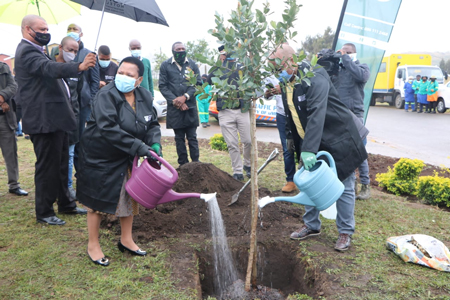Embracing Greening Initiatives in Arbor Month
 Deputy Minister Sotyu and her delegation kicked off Arbor Month with activities at Dumisani Makhaye Village where they planted two Waterberry trees that will not only aid in greening the community but will also help in feeding the community
Deputy Minister Sotyu and her delegation kicked off Arbor Month with activities at Dumisani Makhaye Village where they planted two Waterberry trees that will not only aid in greening the community but will also help in feeding the community
1 September 2021
The Deputy Minister of Forestry, Fisheries and the Environment Ms Makhotso Sotyu has kicked-off the National Arbor Month campaign with planting of trees in Richards Bay, KwaZulu-Natal, where she also announced the City of Cape Town as the winner of the Arbor City Competition in the Metropolitan Municipalities category.
Sponsored by Total South Africa, the Arbor City Competition recognises and rewards cities and towns that have embraced greening initiatives in their programmes. The competition is executed in partnership with the Institute of Environment and Recreation Management and the South African National Biodiversity Institute (SANBI), and seeks to promote the greening of cities and towns in South Africa.
Addressing a handful of community members in the uMhlathuze Local Municipality, Deputy Minister Sotyu encouraged South Africans to plant and conserve trees, emphasising their contribution to climate change mitigation. “Trees and forests are very efficient in sequestrating carbon dioxide. When trees and forests are used to sequestrate carbon dioxide as much as possible and not releasing it quickly, South Africa could have a less costly and more just carbon transition,” she said.
This year’s National Arbor Month will be coordinated under the theme: “Forest Restoration: A path to recovery and well-being”. The theme is adopted from the United Nations Collaborative Partnership on Forests and is congruent to President Cyril Ramaphosa’s call for the planting of ten million trees, for the next five years in South Africa.
As highlighted by the Paris Climate Agreement in 2015, forests and trees play a crucial role in reducing the accumulation of greenhouse gases in the atmosphere. Acting as carbon sinks, they absorb the equivalent of roughly 2 billion tonnes of carbon dioxide each year.
Effective forest management can strengthen resilience and adaptive capacities to climate-related natural disasters, underscoring the importance of integrating forest-based measures into national disaster risk reduction strategies.
Forests and trees outside forests are vital for sustainable development. Forests occupy one-third of the Earth’s surface, and about another half of the total remaining land area features sparsely scattered trees. These renewable natural resources are crucial for tackling many of the issues identified in The Future We Want, such as poverty, food security, climate change, biodiversity, sustainable production and consumption, and social inclusion, particularly meeting the basic needs of vulnerable people and ensuring their well-being.
The theme promotes tree planting for restoration and rehabilitation, creation of sustainable settlements by adding greenery and creation of biodiversity around our residential settlements. Besides improving the aesthetics of our surroundings, fruit trees also improve household food security.
In line with President Ramaphosa’s call, Deputy Minister Sotyu officially announced the Greening Programme that aims to fast-track the planting of 10 million trees over the next five years.
“This means every year we should aim to plant at least two million trees. This target is not only aimed at the national Department of Forestry, Fisheries and the Environment, but to the public in general, government departments, municipalities, public institutions, the corporates, Non-government Organisations, schools, institutions of higher learning and Community Based Organisations,” she said.
Department of Forestry, Fisheries and the Environment
